1 of 8
Downloaded 15 times

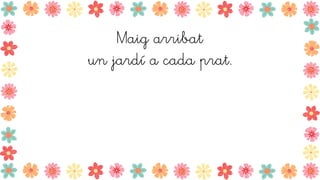
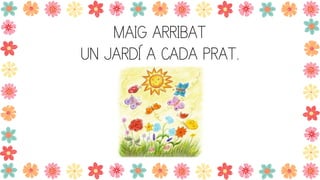
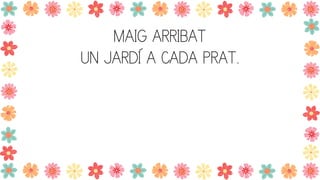
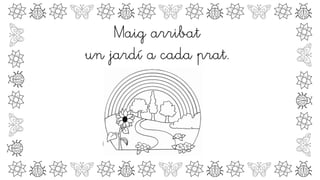


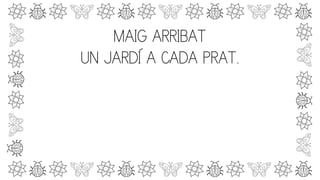
Ad
Recommended
Paraules per fer rodolins
Paraules per fer rodolinsANGELS SUAREZ SANZ
Ã˝
Aquí teniu unes quantes paraules que acaben igual per poder fer rodolinsProjecte els inventors 1r A
Projecte els inventors 1r Aescolanovacervello
Ã˝
The document describes a class of students beginning a project on inventors. They brainstorm potential names for their class and vote to name it "Els Inventors i les Inventores" (The Inventors). The students then research various inventions like the telephone, wheel, paper, light bulb, and locomotive. They create a concept map to organize what they are learning about each invention. The class will work on these inventions over the course of the project and present their findings.Casas Del MundoMafeli
Ã˝
Este documento describe diferentes tipos de viviendas alrededor del mundo, incluyendo casas unifamiliares, pisos, castillos, rascacielos, autocaravanas, casas flotantes, iglús, chozas, casas-barco y casas en los árboles de la selva, destacando sus características principales como materiales de construcción, tamaño, ubicación y número de familias que habitan en cada una.Endevinalles: Animals de la granja
Endevinalles: Animals de la granjaMarianaNavarroHe
Ã˝
This document contains a series of rhyming riddles in Catalan describing various farm animals such as chickens, ducks, cows, pigs, sheep, rabbits, horses and donkeys. Each riddle provides clues to the identity of the animal in 2-3 lines and then reveals the answer. The riddles work to familiarize children with common barnyard animals through an entertaining and engaging format.Fichas egipto
Fichas egiptosea79
Ã˝
The document discusses various aspects of ancient Egyptian civilization. It mentions that Egypt is located in Africa and is crossed by the Nile River, which provided fertile soil during annual floods. Egyptians built large pyramids, including the pyramids of Giza. They also utilized boats made of papyrus to transport goods and fish on the Nile, which was home to dangerous animals like crocodiles. The pharaohs and queens wore elaborate crowns and false beards as symbols of their rulership over both Upper and Lower Egypt.RODOLINS DE GIRAFESmlombar2
Ã˝
El documento trata sobre varias girafas y sus actividades. Describe girafas en la escuela saludando, cocinando, escondiéndose de la lluvia, bailando y pescando. También habla de una girafa bebiendo agua de una garrafa y trepando un árbol con gracia, y de una girafa y elefante haciéndose amigas. Finalmente, menciona dos girafas que se les cayeron los dientes y una girafa resfriada que pidió ayuda a una hada.Projecte dinosaures
Projecte dinosauresescolanovacervello
Ã˝
The document describes a class of students naming their classroom. They debated between calling it "Dinosaurs" or "Butterflies". After presenting arguments for each choice, they voted and the name "Dinosaurs" won by one vote. They then began learning about dinosaurs by bringing in books from home and planning to research different aspects of dinosaurs like how they lived and went extinct.MaCrece frases tarjetas colorSuperPT
Ã˝
El documento describe varias acciones realizadas por diferentes personas y animales. Incluye detalles sobre lo que comen, cómo se mueven y dónde se encuentran una variedad de sujetos como perros, niños, bebés, mujeres, leones, coches, médicos, vacas, policías, cocineras, maestras y abejas.CartellsMonica Roige Sedo
Ã˝
El documento describe lo que es un cartel y sus partes. Un cartel es un papel o cartón que sirve para informar sobre eventos como conciertos, ferias o ofertas. Los carteles incluyen un título e información básica como qué evento se está organizando, quién lo organiza, dónde y cuándo tendrá lugar.Ovípars O vivípars?
Ovípars O vivípars?Jose María Díaz-Crespo Ramírez
Ã˝
El document classifica els animals segons el seu tipus de naixement. Esmenta exemples d'animals ovípars com el cocodril, la tortuga, el pingüí i la granota, i animals vivípars com el gos i l'elefant. També inclou una pregunta retòrica sobre enganyar.Conte el quadratJose María Díaz-Crespo Ramírez
Ã˝
El documento narra las aventuras de un cuadrado, que se transforma en diferentes objetos, como un regalo, una galleta, un espejo y una televisión, mientras interactúa con los niños. Cada transformación del cuadrado refleja su estado de ánimo y su deseo de descansar al final del día. Termina con el cuadrado descansando y pidiendo que no lo despierten.Projecte dels tigres
Projecte dels tigresescolanovacervello
Ã˝
The students in the class chose the name "Tigers" for their class. They discussed and voted on different animal names. They learned about tigers by researching their stripes, teeth, sight, and other features. The students summarized what they knew about tigers and questions they had. They planned to learn more by visiting the library, museum, zoo, and other sources.Poema Nadal el camell despistat
Poema Nadal el camell despistatEli Lucena
Ã˝
A camel asked a boy where the stable was located as it was carrying honey, dried fruits, and olives as gifts. The boy pointed the camel in the right direction and offered to guide it, noticing his own name on one of the toys the camel was bringing to celebrate Christmas.Abecedari de la tardor
Abecedari de la tardorFrancesc Iglesias
Ã˝
This document lists various Catalan words related to nature, weather, and food. It includes plants and animals like chestnut, squirrel, and swallow, as well as items for rain like an impermeable snail and rain jacket. It also mentions nuts, grapes, and a late fall soup. The final words refer to leaves in the wind and quince.More Related Content
What's hot (20)
Endevinalles: Animals de la granja
Endevinalles: Animals de la granjaMarianaNavarroHe
Ã˝
This document contains a series of rhyming riddles in Catalan describing various farm animals such as chickens, ducks, cows, pigs, sheep, rabbits, horses and donkeys. Each riddle provides clues to the identity of the animal in 2-3 lines and then reveals the answer. The riddles work to familiarize children with common barnyard animals through an entertaining and engaging format.Fichas egipto
Fichas egiptosea79
Ã˝
The document discusses various aspects of ancient Egyptian civilization. It mentions that Egypt is located in Africa and is crossed by the Nile River, which provided fertile soil during annual floods. Egyptians built large pyramids, including the pyramids of Giza. They also utilized boats made of papyrus to transport goods and fish on the Nile, which was home to dangerous animals like crocodiles. The pharaohs and queens wore elaborate crowns and false beards as symbols of their rulership over both Upper and Lower Egypt.RODOLINS DE GIRAFESmlombar2
Ã˝
El documento trata sobre varias girafas y sus actividades. Describe girafas en la escuela saludando, cocinando, escondiéndose de la lluvia, bailando y pescando. También habla de una girafa bebiendo agua de una garrafa y trepando un árbol con gracia, y de una girafa y elefante haciéndose amigas. Finalmente, menciona dos girafas que se les cayeron los dientes y una girafa resfriada que pidió ayuda a una hada.Projecte dinosaures
Projecte dinosauresescolanovacervello
Ã˝
The document describes a class of students naming their classroom. They debated between calling it "Dinosaurs" or "Butterflies". After presenting arguments for each choice, they voted and the name "Dinosaurs" won by one vote. They then began learning about dinosaurs by bringing in books from home and planning to research different aspects of dinosaurs like how they lived and went extinct.MaCrece frases tarjetas colorSuperPT
Ã˝
El documento describe varias acciones realizadas por diferentes personas y animales. Incluye detalles sobre lo que comen, cómo se mueven y dónde se encuentran una variedad de sujetos como perros, niños, bebés, mujeres, leones, coches, médicos, vacas, policías, cocineras, maestras y abejas.CartellsMonica Roige Sedo
Ã˝
El documento describe lo que es un cartel y sus partes. Un cartel es un papel o cartón que sirve para informar sobre eventos como conciertos, ferias o ofertas. Los carteles incluyen un título e información básica como qué evento se está organizando, quién lo organiza, dónde y cuándo tendrá lugar.Ovípars O vivípars?
Ovípars O vivípars?Jose María Díaz-Crespo Ramírez
Ã˝
El document classifica els animals segons el seu tipus de naixement. Esmenta exemples d'animals ovípars com el cocodril, la tortuga, el pingüí i la granota, i animals vivípars com el gos i l'elefant. També inclou una pregunta retòrica sobre enganyar.Conte el quadratJose María Díaz-Crespo Ramírez
Ã˝
El documento narra las aventuras de un cuadrado, que se transforma en diferentes objetos, como un regalo, una galleta, un espejo y una televisión, mientras interactúa con los niños. Cada transformación del cuadrado refleja su estado de ánimo y su deseo de descansar al final del día. Termina con el cuadrado descansando y pidiendo que no lo despierten.Projecte dels tigres
Projecte dels tigresescolanovacervello
Ã˝
The students in the class chose the name "Tigers" for their class. They discussed and voted on different animal names. They learned about tigers by researching their stripes, teeth, sight, and other features. The students summarized what they knew about tigers and questions they had. They planned to learn more by visiting the library, museum, zoo, and other sources.Poema Nadal el camell despistat
Poema Nadal el camell despistatEli Lucena
Ã˝
A camel asked a boy where the stable was located as it was carrying honey, dried fruits, and olives as gifts. The boy pointed the camel in the right direction and offered to guide it, noticing his own name on one of the toys the camel was bringing to celebrate Christmas.Abecedari de la tardor
Abecedari de la tardorFrancesc Iglesias
Ã˝
This document lists various Catalan words related to nature, weather, and food. It includes plants and animals like chestnut, squirrel, and swallow, as well as items for rain like an impermeable snail and rain jacket. It also mentions nuts, grapes, and a late fall soup. The final words refer to leaves in the wind and quince.More from Ana Ibarz (6)
Dita primavera
Dita primaveraAna Ibarz
Ã˝
La primavera è arrivata e ha portato molte fiori. Il documento enfatizza la bellezza e la rinascita associata a questa stagione. Ripete l'idea che la primavera porta nuova vita e colore.Ad
Dita maig
- 1. Maig arribat un jardí a cada prat.
- 2. Maig arribat un jardí a cada prat.
- 3. MAIG ARRIBAT UN JARDÍ A CADA PRAT.
- 4. MAIG ARRIBAT UN JARDÍ A CADA PRAT.
- 5. Maig arribat un jardí a cada prat.
- 6. Maig arribat un jardí a cada prat.
- 7. MAIG ARRIBAT UN JARDÍ A CADA PRAT.
- 8. MAIG ARRIBAT UN JARDÍ A CADA PRAT.
